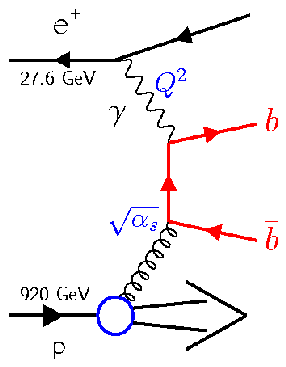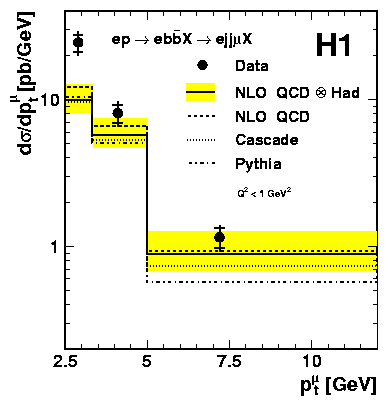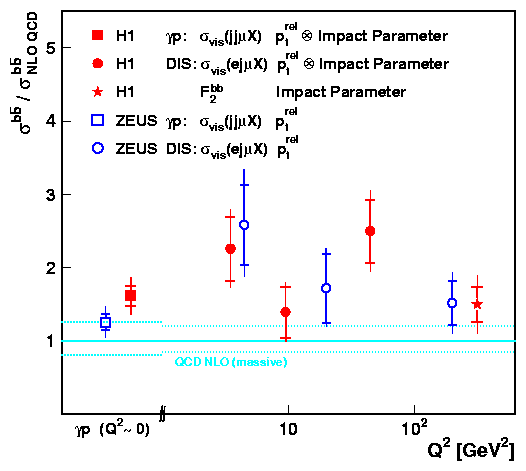
Measurement of Beauty Production at HERA Using Events with Muons and Jets |
Introduction
Measuring beauty production in ep collisions at HERA
is an ideal testing ground for studying the strong force.
The dominant production mechanism
is the boson gluon fusion
process as illustrated in the diagram below.
This process is directly driven by the
gluon density in the proton.
The large mass mb of the beauty quark of about
5 GeV provides a hard kinematical scale,
which allows the calculation of cross sections
by means of perturbative-Quantum-Chromo-Dynamics (pQCD).
Besides the mass of the b quark there can be
additional hard scales available such
as the virtuality Q2
of the exchanged photon or the transverse momenta of
the outgoing b-quarks.
The measurement presented here allows to study the interplay
of the hard scales over a wide
kinematic range. It is performed both in the region of
photoproduction in which the exchanged photon is quasi-real
(Q2 is approximately zero)
and in deep inelastic scattering (DIS), with photon
virtualities 2 < Q2< 100 GeV2.
In the covered phase space it would be expected that
pQCD calulations performed
in the "massive scheme"
at Next-to-Leading Order (NLO)
give reliable results. In this
scheme, u, d and s quarks are the only active flavours in the proton
and the photon, and charm and beauty are produced dynamically
in the hard scattering, as
depicted in the diagram below for the beauty case.
At scales Q2>>m2b
the so called "massless scheme" should be superior, where charm and beauty
quarks are treated as active flavours in
the proton and in the photon, in addition to the light flavours u, d and s.
In this paper we compare the data with NLO predictions
in the "massive scheme". Predictions in the "massless"
scheme are not yet available for the exclusive final states
which we use in our measurement.

Experimental technique
The total beauty production cross-section at HERA is
two orders of magnitude smaller than that of charm and
another magnitude smaller than that of the light quarks.
In this analysis the beauty events
are identified using muons from semileptonic b-decays,
which provide a clean experimental signature.
In addition to the muon the event selection requires
the presence of at least one jet (two jets)
in the DIS (photoproduction) sample.
To separate beauty events from charm and light quark background,
two observables are used, which, for the first time at HERA,
exploit simultaneously
the large mass and the long lifetime of the b-quark, respectively:
1. The relative transverse momentum ptrel of the muon with respect
to the axis of the associated jet: For muons
from b-decays the spectrum extends to much larger values
than for the other sources.
2. The impact parameter delta
of the muon, which is the distance of the
track in the transverse plane with respect to the ep
collision vertex. For muons from b-decays
this takes larger values as compared to the other sources.
The precision measurement
of muon track impact parameters is made possible by
the H1 Central Silicon Track detector (CST).
The fractions of b-quark events in the data samples
are determined from a fit to the two-dimensional distribution of
ptrel and delta.
Results
The figure below shows as an examplary result
the beauty cross sections
in the photoproduction kinematic regime as a function
of the transverse momentum of the muon.
The data are compared to predictions from the massive
NLO calculation.
The yellow bands estimate the uncertainties of this prediction.
The data are also compared to predictions from the
leading order Monte Carlo
generator programs CASCADE (dotted line) and PYTHIA (dash-dotted lines).
Observation: The data are in all bins above the predictions, the excess being
most prominent at the lowest momenta.

The figure below summarises
the recent beauty production cross section measurements at HERA
as a function of the photon virtuality Q2.
The plot shows the ratio of
measured cross section to the NLO QCD prediction.
The results of this paper (full circles and squares)
are compared with other recent beauty production
measurements from ZEUS and H1.
The dotted lines indicate the typical uncertainties
of the theory calculations.
Observation: A wide range in Q2 is stretched by
the measurements. The data are in all bins somewhat above the predictions,
with no clear trend as a function of Q2.

So what did we learn?
The measurement of beauty production in ep collisions
at HERA is an interesting playground for our understanding of
the strong force. In this analysis we have studied the
production over a wide kinematical range of the resolving
power of the photon emitted by the electron - from
the photoproduction regime with photon virtualities Q2
of about zero to the DIS regime with Q2
reaching up to 100 GeV2.
While it is expected that the perturbative QCD calculations
in the massive scheme performed at next-to-leading order
would give reliable predictions of the cross-sections,
the cross-sections which we measured for a final state
with a muon and jets seem to generally be somewhat above the
calculations, rather independent of the Q2.
An excess is observed at small transverse momenta of the
muons or equivalently at small transverse momenta of the
produced b-quarks.